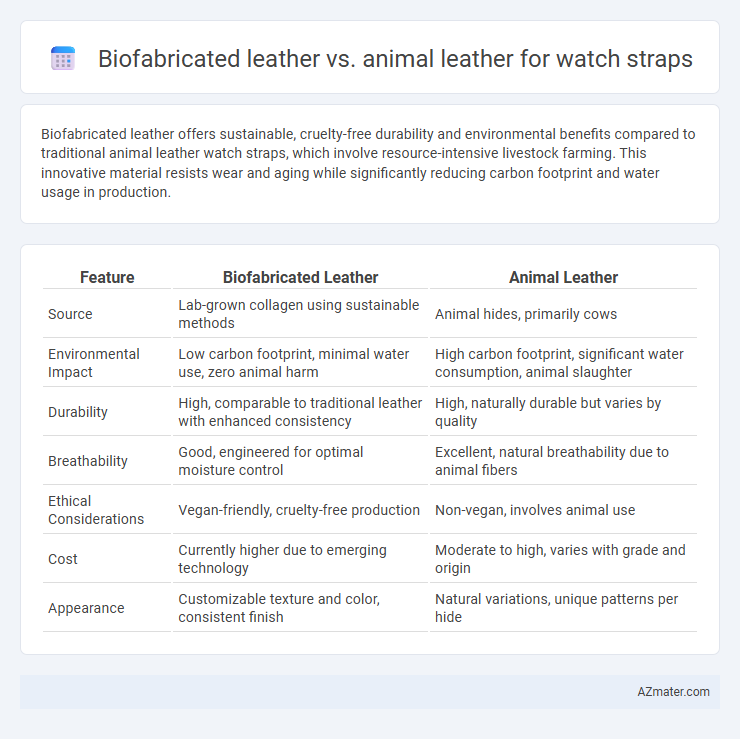Biofabricated leather offers sustainable, cruelty-free durability and environmental benefits compared to traditional animal leather watch straps, which involve resource-intensive livestock farming. This innovative material resists wear and aging while significantly reducing carbon footprint and water usage in production.
Table of Comparison
| Feature | Biofabricated Leather | Animal Leather |
|---|---|---|
| Source | Lab-grown collagen using sustainable methods | Animal hides, primarily cows |
| Environmental Impact | Low carbon footprint, minimal water use, zero animal harm | High carbon footprint, significant water consumption, animal slaughter |
| Durability | High, comparable to traditional leather with enhanced consistency | High, naturally durable but varies by quality |
| Breathability | Good, engineered for optimal moisture control | Excellent, natural breathability due to animal fibers |
| Ethical Considerations | Vegan-friendly, cruelty-free production | Non-vegan, involves animal use |
| Cost | Currently higher due to emerging technology | Moderate to high, varies with grade and origin |
| Appearance | Customizable texture and color, consistent finish | Natural variations, unique patterns per hide |
Introduction: The Evolution of Watch Strap Materials
Biofabricated leather represents a cutting-edge evolution in watch strap materials by offering sustainable and eco-friendly alternatives to traditional animal leather, which has dominated the industry for decades. Engineered through cellular agriculture, biofabricated leather mimics the texture, durability, and aesthetics of animal leather while significantly reducing environmental impact and ethical concerns. Innovations in biofabricated leather production are reshaping consumer preferences and advancing the luxury watch market toward more responsible and innovative material choices.
What is Biofabricated Leather?
Biofabricated leather is a sustainable material created through cellular agriculture, where animal cells are cultivated in labs to grow collagen and reconstruct leather without harming animals. This innovative alternative mimics the texture, durability, and appearance of traditional animal leather while reducing environmental impact by lowering carbon emissions and eliminating the need for livestock farming. Its application in watch straps offers a cruelty-free, eco-conscious option that maintains premium quality and resilience.
How Animal Leather is Produced
Animal leather for watch straps is produced through a process involving the slaughter of animals, primarily cows, followed by tanning to transform rawhide into durable material. The tanning process uses chemicals such as chromium salts or vegetable tannins to prevent decay and enhance flexibility, often resulting in significant environmental pollution. This production method also involves high water consumption and greenhouse gas emissions, raising sustainability and ethical concerns compared to biofabricated leather alternatives.
Environmental Impact: Biofabricated vs Animal Leather
Biofabricated leather for watch straps significantly reduces environmental impact by minimizing water usage, greenhouse gas emissions, and land exploitation compared to traditional animal leather. Animal leather production relies heavily on cattle farming, which contributes to deforestation, methane emissions, and extensive chemical tanning processes that pollute water systems. Biofabricated leather offers a sustainable alternative with lower carbon footprint and reduced ecological degradation, aligning with eco-friendly consumer demands.
Durability and Performance Comparison
Biofabricated leather offers enhanced durability through engineered fibers designed to resist wear, water, and sweat, outperforming traditional animal leather in long-term resilience. Animal leather, while naturally durable and developing a unique patina over time, tends to absorb moisture and degrade faster under constant exposure to sweat and environmental elements. Performance-wise, biofabricated leather maintains consistent texture and flexibility, making it a superior choice for watch straps requiring both durability and comfort.
Aesthetic Differences and Design Potential
Biofabricated leather offers a consistent texture and customizable color palette, enabling avant-garde watch strap designs that surpass the natural variations found in animal leather. Its uniform surface allows for precise embossing and intricate patterns, expanding creative possibilities for luxury watchmakers. In contrast, animal leather showcases unique grain patterns and natural imperfections that contribute to a classic, organic aesthetic favored in traditional strap designs.
Comfort and Wearability for Consumers
Biofabricated leather watch straps offer superior breathability and flexibility, enhancing long-term comfort by reducing sweat accumulation and skin irritation compared to traditional animal leather. Animal leather, while durable, tends to stiffen over time and may cause discomfort in hot or humid conditions due to limited moisture-wicking properties. Consumers seeking lightweight, hypoallergenic, and eco-friendly alternatives often prioritize biofabricated leather for its consistent softness and adaptability during daily wear.
Ethical Considerations and Consumer Choices
Biofabricated leather for watch straps offers a sustainable alternative to traditional animal leather, reducing the ethical concerns related to animal cruelty and environmental degradation. Consumers choosing biofabricated leather support cruelty-free products and lower carbon footprints, aligning with growing demand for eco-conscious fashion. Animal leather, while prized for its durability and luxury appeal, faces increasing scrutiny over animal welfare practices and deforestation impacts, influencing ethical consumer decisions.
Cost and Market Accessibility
Biofabricated leather for watch straps offers a cost-effective alternative to traditional animal leather, with production costs decreasing due to advancements in biotechnology and scalable manufacturing. Market accessibility of biofabricated leather is rapidly expanding through online platforms and sustainable fashion brands, while animal leather remains more established but faces challenges related to ethical concerns and environmental regulations. Consumers seeking affordable, cruelty-free watch straps increasingly prefer biofabricated leather, driving its growth in both luxury and mass-market segments.
Future Trends in Watch Strap Innovation
Biofabricated leather, produced through sustainable biotechnological processes, offers a cruelty-free and eco-friendly alternative to traditional animal leather, reducing environmental impact and resource consumption. Future trends in watch strap innovation emphasize customizable textures, enhanced durability, and integration of smart materials that promote breathability and antimicrobial properties. The rise of biofabricated materials aligns with growing consumer demand for ethical luxury, positioning them as a key driver in the evolution of watch strap design and sustainability.

Infographic: Biofabricated leather vs Animal leather for Watch strap
 azmater.com
azmater.com